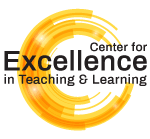Teaching ResourcesThe Center for Excellence in Teaching and Learning invites you to browse the Resources and Scholarly Publications made available to the public. Feel free to download these materials as needed. Assessment TechniquesRead about techniques that can be used to show that learning is occurring in our classes. Explore strategies designed to gauge learning within and across academic disciplines and instructional modalities, with an eye towards customized solutions for our classes. Discover how Learning Assessment Techniques (LATs) and Classroom Assessment Techniques (CATs) can be used to show what and how well our students are learning in real time, and what we can do to enhance student engagement and learning gains. Resource Materials
Balancing Learning and GrowthLearning is the acquisition of knowledge or skills through experience, study, or by being taught. Growth is the result of achieving positive changes in quality of life through broadening values, expanding life vision, and strengthening key identities. Integrating learning and growth requires deliberate planning, facilitation, and assessment. Explore an educational framework that promotes both learning and growth. Resource Materials
Copyright & Fair UseThe University of Idaho Library hosts an extensive website to assist the university community with issues of copyright. The homepage also functions as the University of Idaho Copyright Policy, and includes information on: High-Impact PracticesHigh Impact Practices (HIPs) have been shown to have a significant positive impact on student learning, engagement, and retention. Gain familiarity with the research on HIPs and explore an inventory of evidence-based teaching and learning practices. Faculty and staff interested in developing and implementing high impact pedagogies, practices, and programs are encouraged to review the materials listed below.
Leading Effective DiscussionsUpwards of 80% of college faculty report that class discussion is their dominant and preferred method of instruction. In addition to ranking among the most-used pedagogical techniques, scholars such as McKeachie have argued that it is also one of the most valuable. There is, however, a distinction between "a discussion" and "a good discussion." Pedagogically, we should learn from the experience. Further, and perhaps especially in these times, we need to be able to facilitate effective discussions in our classes. Read the resource materials provided below to learn how discussion can be used to help students develop and present ideas, respond appropriately to others, and illustrate the value of logic, evidence, and collaborative learning. Meaningful FeedbackOur goal as teachers is to help our students learn. One sure-fire way to make this connection is by designing and linking good assignments to good feedback, and by giving students the opportunity to improve through our input. How can you create "transparent" assignments that make sense to the students? How do you give good, useful, and timely feedback that helps student thrive and improve? How should you share your assessment of student progress and performance (including grades in Canvas) throughout the semester?
MetacognitionIf you are interested in meaningful critical refection, how students can articulate their learning, and how a simple “cognitive wrappers” rubric can help students become more aware of their learning experiences in the classroom, in the field, or abroad, please check out the resource materials provided below. Learn about strategies and models that help students understand, articulate, and assess their learning processes, experiences, and findings within, across, and beyond the curriculum. Faculty seeking to develop and enhance community-, civic-, and (global) service-learning classes may find these resources particularly applicable to their interests and efforts.
Teaching for LearningThere is a growing body of research examining the effectiveness of various teaching methods in the support of learning. Read the resource materials listed below to learn about how you might improve your teaching by studying this new science of learning.
Teaching Large ClassesThe best research on “teaching and learning in large classes” focuses less on "how large is too large" and more on strategies for engaging students (and managing our effort) when the faculty to student ratio induces the belief that something’s got to give. Use the resource materials below to explore the assumptions, challenges, and opportunities that come with teaching larger classes, as well as strategies to increase engagement, decrease anonymity, and balance instructional effort.
Three Steps to Student LearningExamine the proposition that all learning—even the silent stuff—is active learning. Learn about strategies you can use to promote, recognize, and assess learning in its various forms. Based on research from the new science of learning, read about how to (1) gain and sustain attention, (2) facilitate cognitive engagement, and (3) provide opportunities for students to apply knowledge to different circumstances and contexts.
Transparency in Learning & Teaching (TILT)TILT (Transparency in Learning and Teaching in Higher Education) consists of a number of strategies that can be applied across the curriculum and in various contexts, including assignments, curricula, assessments, and strategic initiatives designed to enhance student success equitably. It is based on an award-winning educational development and research project and helps faculty design and implement a transparent teaching framework to promote student success,
Universal Design for LearningUniversal Design for Learning (UDL) explicitly acknowledges and addresses multiple means of expression, representation, and engagement to create meaningful learning experiences for ALL students. It is not about changing our teaching to accommodate individual students; it is about broadening our understanding of the different ways that students can learn and demonstrate their learning, and how we can build that into our classes and assignments.
Additional Resources |

